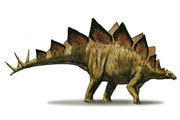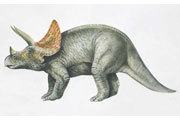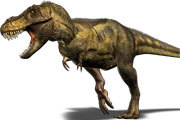Duckbilled dinosaurs were named after their duck-like beak. They were all herbivores (plant eaters) and used their beaks to chop up tough plants. In Alberta, Canada, there were a large variety of duckbills and because of this we know a lot about this type of dinosaur. Of all the duckbilled dino's, Parasaurolophus was the most unusual looking.
Parasaurolophus had a long, hollow, bony crest growing out of the back of its head - like a bad hairdo blown by the wind. This strange crest was bigger than its head. Some of them were up to 6 feet (1.8 meters) long! Parasaurolophus' nostril (at the end of its snout) went up the crest and back down again, creating four tubes. Males might have had longer crests. There was also an indent in its back from where the crest would have rubbed when it leaned its head back.
Scientists think the large crest was used for making noises, making its sense of smell better or for attracting a mating partner. A reconstructed skull had air chambers, missing parts and soft tissues added to it. It was then tested to see what sounds it might have made. "It sounds a little out of this world, like a giant is clearing his throat," said Tom Williamson of New Mexico Museum of Natural History. "It's the kind of sound that would easily be heard by other animals through a thick rain forest." Because scientists don't know if Parasaurolophus had vocal cords, they tested sounds made both with and without vocal cords.
Parasaurolophus lived during the late Cretaceous period, about 65-75 million years ago. It grew to about 33 feet long (10 meters) and 16 feet tall (5 meters.) Just like Corythosaurus, this is another dinosaur that wouldn't have had its skin used for luggage. It was covered in bumps. There is a debate whether or not it had mitten-like hands. Some paleontologists think the web-like hands became that way during the fossilization process. It also had good eyesight and great hearing but it had no way to defend itself.
Fossils from this pointy tailed dino have been found all over North America. In 1923 Dr. William A. Parks found an almost complete skeleton in Alberta. Other fossils have been found in New Mexico and Utah in the USA.
Related Stories:

































